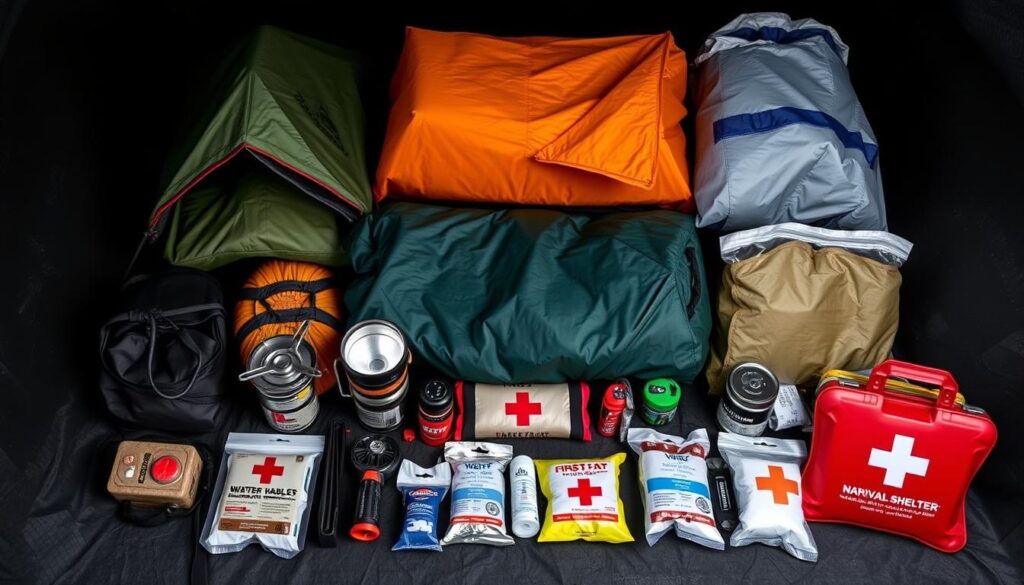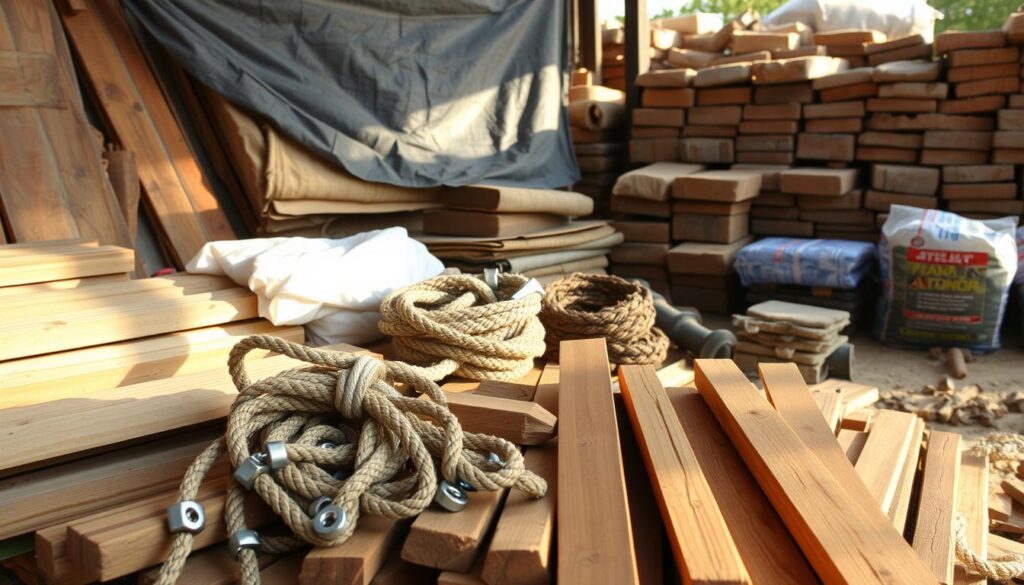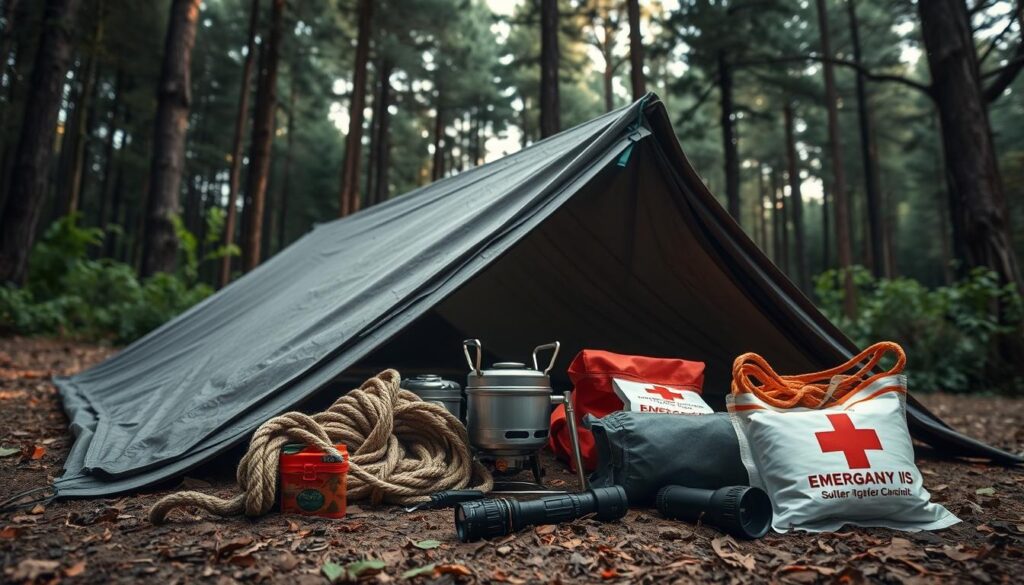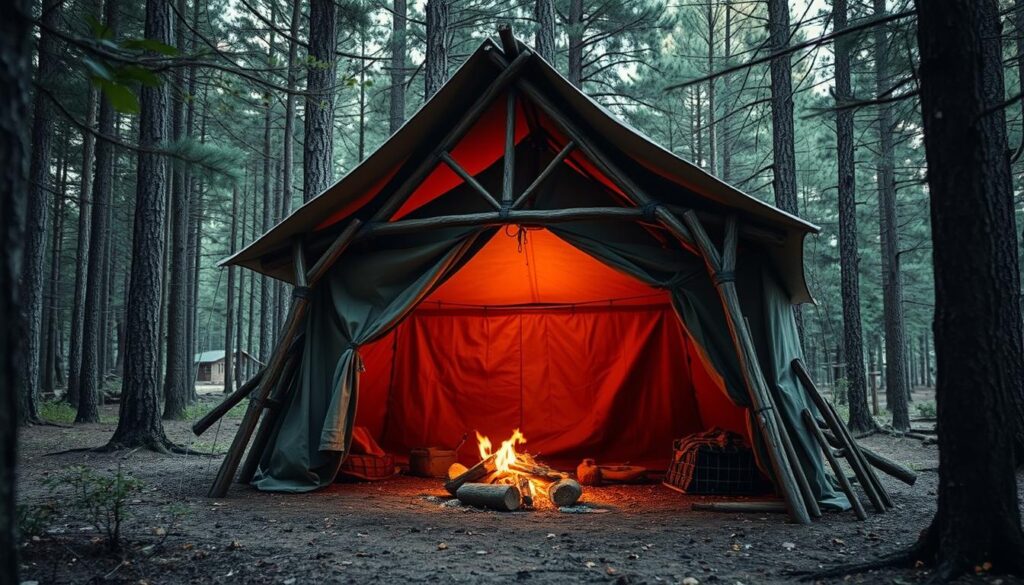When disaster hits, the right gear can save lives. I’ve seen how a good disaster kit can really help in tough times.
Being ready for emergencies means having the right basic shelter necessities. In this article, I’ll share my top picks for portable shelter solutions to help you through storms.
Having the right shelter essentials gives you peace of mind and protection when you need it most. I’ll tell you what to put in your kit.
Key Takeaways
- Understanding the importance of shelter in emergency situations
- Identifying the basic items to include in your disaster supplies kit
- Learning about portable shelter solutions for different scenarios
- Recognizing the role of shelter in survival situations
- Preparing a shelter kit with the right essentials
Understanding the Importance of Shelter Essentials
Shelter essentials are key in survival situations. The right gear can save lives when disaster hits.
Shelter essentials help create a safe place in emergencies. Items like tents, tarps, and sleeping bags keep people safe from bad weather.

What Are Shelter Essentials?
Shelter essentials include survival shelter equipment for protection and comfort. This includes the shelter itself and tools to build and secure it, like ropes and stakes.
Knowing what shelter essentials are is vital for emergency prep. It helps people get ready for crisis situations.
Why Shelter Essentials Matter in Crisis Situations
In emergencies, disaster relief shelter items are essential for safety and comfort. They protect against harsh weather, wildlife, and other dangers, boosting survival chances.
Having the right shelter gear also lowers stress and improves well-being in emergencies. It lets people focus on survival and recovery.
Basic Shelter Types for Emergencies
The right shelter is key in emergencies, providing safety and protection. Here, we’ll look at different shelters for emergency situations.
Tents: A Portable Option
Tents are great for emergencies because they’re easy to carry and set up. They come in many sizes, fitting different numbers of people. Look for a tent that’s durable, water-resistant, and easy to put together.
Key Features of Emergency Tents:
- Lightweight and compact for easy carrying
- Waterproof and wind-resistant materials
- Simple and quick setup
Tarps: Versatile and Lightweight
Tarps are versatile for emergency shelters. They’re light, compact, and can be set up in many ways. You can use them alone or with other materials.
Benefits of Tarps:
- Extremely lightweight and compact
- Can be used in multiple configurations
- Provides protection from rain and wind
Natural Shelters: Using Nature to Your Advantage
Natural shelters can be enough in some emergencies. Caves, rock overhangs, and snowbanks are examples. Knowing how to find and use these can be very helpful.
Examples of Natural Shelters:
- Caves and rock overhangs
- Hollowed-out snowbanks
- Groups of trees or other natural formations
Here’s a comparison of the different shelter types:
| Shelter Type | Portability | Setup Ease | Protection Level |
|---|---|---|---|
| Tents | High | Easy | High |
| Tarps | Very High | Moderate | Moderate |
| Natural Shelters | N/A | Varies | Varies |
Key Shelter Building Materials
The right materials are key to a good shelter. Think about your environment and what you can find to build it.

Having the right shelter essentials is vital. Insulation and frame materials are two must-haves for any shelter.
Insulation Materials: Keeping Warm
Insulation keeps you warm and protects from bad weather. Stuff like sleeping bags, warm blankets, and dry leaves work well.
Thermal insulation cuts down on heat loss. This keeps your shelter warm. Choose materials that are light, strong, and keep warmth well.
- Sleeping bags: They’re warm and comfy, making them key for any shelter.
- Blankets: They’re light and flexible, great for insulation or as a signal.
- Dry leaves or pine needles: Nature offers great insulation for survival.
Frame Materials: Ensuring Stability
The shelter’s frame is its backbone. Survival shelter equipment includes poles, stakes, and ropes for a strong frame.
Look for materials that are strong, last long, and handle weather well. A solid frame keeps your shelter safe.
- Poles: Wood or metal, they’re key for the shelter’s skeleton.
- Stakes: They keep the shelter grounded and stable.
- Ropes and cordage: They add support and stability to the frame.
In summary, picking the right basic shelter necessities is essential. Focus on insulation and frame materials for a safe, warm shelter.
Essential Tools for Shelter Construction
Having the right tools is key to building a good shelter. It’s important to have a kit ready for emergencies. This kit should have all the essential tools you need.
Multi-tools are very useful. They can help with tasks like cutting branches and opening cans. A good multi-tool makes your kit lighter and more functional.
Multi-tools: The Ultimate Companion
A multi-tool is a must-have for any outdoor or emergency situation. It usually has a knife, scissors, pliers, and screwdrivers. Look for one that’s durable, won’t rust, and feels good in your hand.
For example, a multi-tool can help you cut rope for a makeshift tow line or fix your gear. Its many uses make it a key item for building shelters and survival tasks.
Ropes and Cordage: Versatile Solutions
Ropes and cordage are important for securing shelters and making quick fixes. When picking ropes, think about the material, how durable it is, and its thickness. Nylon and polyester ropes are good because they’re strong and weather-resistant.
| Rope Type | Material | Diameter | Strength |
|---|---|---|---|
| Nylon Rope | Nylon | 1/4 inch | High |
| Polyester Rope | Polyester | 3/8 inch | Very High |
| Paracord | Nylon | 1/8 inch | High |
Tarps and Covers: Protection from the Elements
Tarps and covers keep you safe from rain, wind, and sun. They can make a waterproof roof or a dry ground tarp. Choose a tarp based on its size, material, and how well it keeps water out.

In summary, having the right tools is vital for building a safe shelter. Make sure your emergency kit includes multi-tools, ropes, and tarps. This way, you’ll be ready for any unexpected situation.
Personal Safety Gear and Shelter Essentials
Personal safety gear is key to any emergency plan, along with shelter essentials. The right gear can greatly improve your survival and comfort in crises.
Personal safety gear includes first aid kits and fire starting kits. These are vital for treating injuries and for warmth and cooking.
First Aid Kits: Be Prepared for Injuries
A good first aid kit is essential in emergencies. It should have bandages, antiseptic wipes, pain relievers, and any needed medications. It’s for all kinds of injuries.
When making a first aid kit, think about the injuries you might face and how many people you’re preparing for. Also, check the kit often to make sure everything is good to use and not expired.
Fire Starting Kits: Creating Warmth and Cooking
A fire starting kit is also very important. Fire gives warmth, a way to cook food, and to purify water. You can start a fire with lighters, matches, or firestarters.
When picking a fire starting kit, think about how easy it is to use, how reliable it is, and where you’ll be using it. For example, a waterproof match case or a ferrocerium rod works well in wet or windy weather.
In summary, personal safety gear like first aid kits and fire starting kits is vital for survival and comfort in emergencies. With the right gear, you can better handle crisis situations.
Emergency Food and Water Supply
Having a good emergency food and water supply is key. In disasters, having food and water can save lives. It’s a matter of survival.
When getting ready for emergencies, think about non-perishable food and safe water. The American Red Cross says you should have at least three days’ worth of non-perishable food and water.
Non-Perishable Food Options
Choosing the right non-perishable foods is important. Look for foods high in calories, protein, and nutrients. Here are some good options:
- Canned goods (vegetables, fruits, meats)
- Dried legumes (beans, lentils)
- Nuts and dried fruits
- MREs (Meals Ready to Eat)
- Energy bars
Remember to consider any dietary needs or allergies when picking food. For more tips on emergency kits, check out https://www.ready.gov/kit.
| Food Type | Nutritional Value | Shelf Life |
|---|---|---|
| Canned Goods | High in protein and fiber | 2-5 years |
| Dried Legumes | Rich in protein and fiber | Up to 10 years |
| Nuts and Dried Fruits | High in healthy fats and fiber | 6-12 months |
Water Filtration: Ensuring Safe Drinking
Having safe drinking water is as important as food. In emergencies, water can get contaminated. That’s why water filtration is key for survival kits.
“Clean drinking water is essential for survival. Without it, the risk of waterborne diseases increases significantly.”
There are many ways to purify water, including:
- Boiling
- Water filtration systems (e.g., LifeStraw)
- Chemical disinfection (e.g., chlorine tablets)
- Solar disinfection (SODIS)
Each method has its own benefits. Boiling works well but needs a heat source. Portable filters are handy but have limits.
Shelter Comfort Innovations
In the world of outdoor shelter gear, new ideas have made outdoor adventures more fun and lasting. This is thanks to the latest in comfort technology.
Sleeping Gear: Staying Rested
Getting a good night’s sleep is key for feeling refreshed and healthy. Sleeping bags and sleeping pads are must-haves for a comfy night. Today’s sleeping bags keep you warm without being too heavy.
Sleeping bags with synthetic insulation are warm and dry fast, perfect for wet weather. Also, inflatable sleeping pads add comfort and keep you warm from the ground. They make sleeping outdoors much better.
Climate Control: Keeping Comfortable
Keeping your shelter at a good temperature is important. It stops you from getting too hot or too cold. Portable fans and heating solutions help control the shelter’s temperature.
- Portable fans help keep you cool by moving air around.
- Heating solutions, like portable heaters, make cold places more cozy.
Also, using reflective materials on shelters can reflect sunlight and heat. This keeps the inside cooler. These tools are essential for making shelters safe and comfy in emergencies.
Planning Your Shelter Setup
Planning your shelter setup is key to being ready for disasters. A good plan can help you survive and stay comfortable during emergencies.
Mapping Out Your Location
Start by mapping out where you are. Know your area, including dangers and resources. This helps find a safe and easy-to-reach shelter spot.
Being near water is good, but watch out for flooding. Use a map to find the best places for your shelter. Look for spots that protect you from bad weather and dangers.
Group Dynamics: Working Together
It’s important to know how to work with others in your shelter. Often, you’re with family, friends, or community. Working together makes your shelter better.
Some can gather disaster relief shelter items like tents. Others can start fires or find food. This teamwork makes things faster and keeps everyone’s spirits up.
Plan well for your shelter, including where you are and how to work with others. This preparation is vital for surviving emergencies. It’s a must-have for your survival shelter equipment and basic shelter necessities.
Conclusion: Essential Takeaways for Shelter Preparedness
Being ready is vital when emergencies strike. Having the right emergency shelter supplies and portable solutions can greatly help. They make a big difference in tough times.
Preparing for the Unexpected
It’s smart to check your emergency kit often. Make sure it’s up to date and ready for anything. Replace food and supplies every six months to keep them fresh.
Staying Ready
Knowing what shelter essentials are important helps a lot. With a good emergency kit, you can handle emergencies better. Stay ahead, stay ready, and have the right shelter gear to keep you safe.
FAQ
What are the most essential items to include in a shelter kit?
Key items for a shelter kit are a tent, tarp, and sleeping bag. Also, include insulation, a multi-tool, rope, and a first aid kit. These help protect, comfort, and build your shelter.
What type of shelter is best for emergency situations?
The best shelter varies by environment and resources. Tents, tarps, and natural shelters are good choices. Tents are portable and comfy, while tarps are light and flexible. Use natural shelters when you can.
How can I ensure safe drinking water in an emergency situation?
Use water filters or purification tablets for safe water. Boiling is also effective. Having a way to get safe water is key to staying hydrated.
What are some non-perishable food options for emergency situations?
Good non-perishable foods are energy bars, canned goods, dried fruits, and nuts, and MREs. They’re light, nutritious, and easy to store in a kit.
How can I maintain a comfortable temperature within my shelter?
Use insulation like foam or fiberglass to stay warm. Portable heaters or fire kits can also warm you up. For cool weather, use shade, ventilation, and cooling packs.
What are some essential tools for shelter construction?
Important tools are a multi-tool, rope, and tarp. They help build, secure, and maintain your shelter. A multi-tool is versatile, rope secures, and tarps protect from the elements.
How can I plan and prepare for shelter setup in an emergency situation?
Plan by mapping your location and assessing the environment. Work with your group to set up a safe shelter. Consider terrain, weather, and resources when choosing your shelter.
What are some innovations that can enhance shelter comfort?
Improvements include sleeping gear like bags and pads, and climate control like heaters and cooling packs. These keep you comfortable and ensure a good night’s sleep.
Why is it essential to have a first aid kit in a shelter?
A first aid kit is vital for treating injuries and preventing infections. It should have bandages, antiseptic wipes, pain relievers, and any needed medications.
What are some basic shelter necessities that I should always have?
Essential items are a tent, tarp, sleeping bag, insulation, and a first aid kit. These provide a safe and comfy shelter. Add a multi-tool, rope, and non-perishable food to your kit too.



